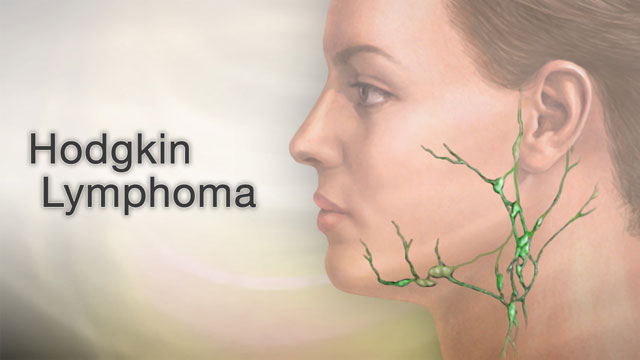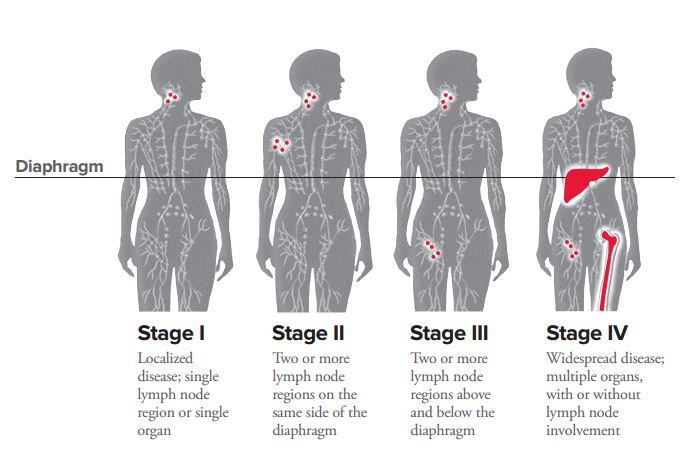Hodgkin’s Disease symptoms
Hodgkin’s Disease symptoms are a type of blood cancer that starts in the lymphatic system. It involved a single arterial group of nodes(cervical, mediastinal, Para-aortic). It involves a single group of nodes spread to automatically contiguous lymphoid tissue. The lymph system is made up of tissues and organs that produce, store, and carry white blood cells.
Types of Hodgkin Lymphoma:
Hodgkin lymphoma is classified into two main types: classical Hodgkin lymphoma and nodular lymphocyte-predominant Hodgkin lymphoma. The classification is based on the microscopic appearance of the cancer cells and the surrounding tissue. The majority of Hodgkin lymphoma cases fall into the classical subtype, which includes several distinct subtypes.
1. Classical Hodgkin Lymphoma (CHL):
a. Nodular Sclerosis Hodgkin Lymphoma (NSHL):
- Characteristics: This subtype is characterized by the presence of Reed-Sternberg cells and a background of fibrosis (scarring) within the lymph node.
- Incidence: Nodular sclerosis Hodgkin lymphoma is the most common subtype, accounting for a significant percentage of classical Hodgkin lymphoma cases.
- Demographics: It is often diagnosed in young adults and is more common in females.
b. Mixed Cellularity Hodgkin Lymphoma (MCHL):
- Characteristics: Mixed cellularity Hodgkin lymphoma is characterized by a mix of Reed-Sternberg cells and inflammatory cells.
- Incidence: It is more common in older adults and is associated with a higher risk of advanced-stage disease.
- Demographics: MCHL is more common in males.
c. Lymphocyte-Rich Hodgkin Lymphoma (LRHL):
- Characteristics: This subtype is characterized by a predominance of lymphocytes and scattered Reed-Sternberg cells.
- Incidence: Lymphocyte-rich Hodgkin lymphoma is less common than nodular sclerosis and mixed cellularity subtypes.
- Demographics: It is often diagnosed in younger adults and is associated with a favorable prognosis.
d. Lymphocyte-Depleted Hodgkin Lymphoma (LDHL):
- Characteristics: This subtype is characterized by few lymphocytes and a higher number of Reed-Sternberg cells.
- Incidence: Lymphocyte-depleted Hodgkin lymphoma is less common and is often associated with advanced-stage disease.
- Demographics: It is more common in older adults and is associated with a poorer prognosis.
2. Nodular Lymphocyte-Predominant Hodgkin Lymphoma (NLPHL):
a. Characteristics:
- Lymphocyte Predominance: Nodular lymphocyte-predominant Hodgkin lymphoma is characterized by the presence of lymphocyte-predominant cells (L&H cells) and lacks the typical Reed-Sternberg cells seen in classical Hodgkin lymphoma.
- Nodular Pattern: It is characterized by a nodular pattern within the lymph node.
b. Incidence:
- Less Common: Nodular lymphocyte-predominant Hodgkin lymphoma is less common than classical Hodgkin lymphoma.
c. Prognosis:
- Favorable: It is generally associated with a more favorable prognosis compared to most subtypes of classical Hodgkin lymphoma.
It’s important to note that the classification and subtyping of Hodgkin lymphoma are based on microscopic examination of tissue samples obtained through biopsy. The specific subtype and staging of Hodgkin lymphoma play a crucial role in determining the most appropriate treatment approach and predicting prognosis.
Causes of Hodgkin’s Disease
The exact cause of Hodgkin’s disease is not well understood, but several factors may contribute to its development. These factors include:
- Genetic Factors: Individuals with a family history of Hodgkin’s disease may have a higher risk of developing the condition. Although the majority of cases occur sporadically, a genetic predisposition may play a role in some instances.
- Immunodeficiency: People with weakened immune systems, either due to a medical condition (such as HIV/AIDS) or immunosuppressive medications, have an increased risk of developing Hodgkin’s disease. A properly functioning immune system is crucial for controlling abnormal cell growth.
- Epstein-Barr Virus (EBV) Infection: Infection with the Epstein-Barr virus, a member of the herpesvirus family, has been linked to an increased risk of Hodgkin’s disease. However, most people infected with EBV do not develop Hodgkin’s lymphoma, and the relationship is complex and not fully understood.
Symptoms of Hodgkin’s disease
- Swelling of Lymph nodes
- Fever
- Fatigue
- Night sweats
- Breathlessness
- Weight loss
- Persistent Cough
- Itchy skin
Diagnosis of Hodgkin’s Disease
- Complete Blood Count
- CT Scan
- X-Ray
- Lymph Nodes Biopsy
- Bone Marrow Biopsy
- Echocardiogram
- Thoracentesis
Treatment of Hodgkin’s Disease
- Chemotherapy
- Radiation therapy
- Immunotherapy or stem cell transplant, especially if other treatments have not worked
FAQs:
What is Hodgkin’s disease?
- Hodgkin’s disease, also known as Hodgkin’s lymphoma, is a type of cancer that originates in the lymphatic system. It is characterized by the abnormal growth of cells called Reed-Sternberg cells.
2. What are the symptoms of Hodgkin’s disease?
- Common symptoms include swollen lymph nodes, fatigue, unexplained weight loss, fever, and night sweats. However, symptoms can vary from person to person.
3. How is Hodgkin’s disease diagnosed?
- Diagnosis involves a combination of medical history, physical examination, imaging studies (such as CT scans), and a biopsy of an affected lymph node or other involved tissue.
4. What are the stages of Hodgkin’s disease?
- Hodgkin’s disease is staged from I to IV based on the extent of the disease. Staging takes into account factors such as the number of affected lymph nodes, the involvement of other organs, and systemic symptoms.
5. What is the treatment for Hodgkin’s disease?
- Treatment options may include chemotherapy, radiation therapy, and in some cases, stem cell transplantation. The specific treatment plan depends on the stage and characteristics of the disease.
6. What is the prognosis for Hodgkin’s disease?
- The prognosis varies depending on the stage of diagnosis and other factors. Hodgkin’s disease is generally considered one of the more treatable forms of cancer, with a high overall survival rate.
7. Can Hodgkin’s disease be prevented?
- There is no known way to prevent Hodgkin’s disease. However, maintaining a healthy lifestyle and avoiding known risk factors, such as exposure to certain viruses or environmental toxins, may help reduce the risk.
8. Is Hodgkin’s disease hereditary?
- While there may be a genetic component to some cases, Hodgkin’s disease is generally not considered a hereditary condition. Most cases occur sporadically.
9. Can Hodgkin’s disease recur after treatment?
- Yes, there is a possibility of recurrence, and patients are typically monitored closely after treatment. Regular follow-up appointments and imaging studies are common to detect any signs of recurrence early.
10. Can Hodgkin’s disease be cured? – Many cases of Hodgkin’s disease respond well to treatment, and a significant number of individuals are cured. The prognosis has improved significantly over the years with advancements in medical treatments.




[…] Weakness: The symptoms of C. difficile infection, coupled with dehydration and illness, can lead to fatigue and weakness, impacting daily […]
[…] but it generally falls between 27 to 33 picograms (pg) per cell. Understanding the normal range of MCH values is essential for interpreting test results […]